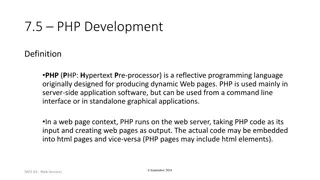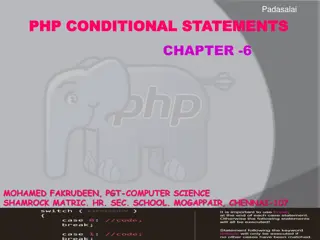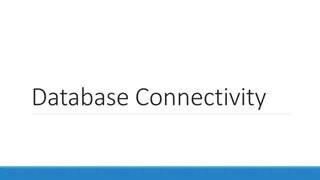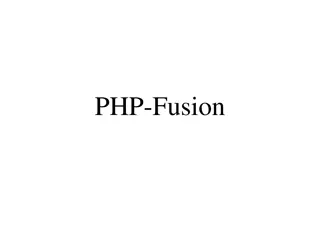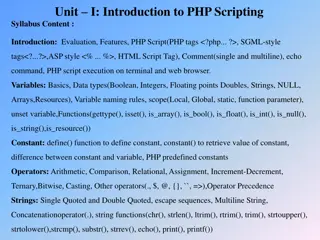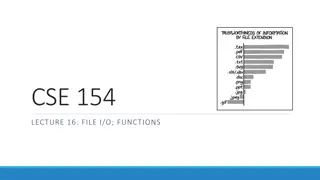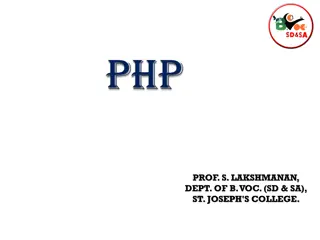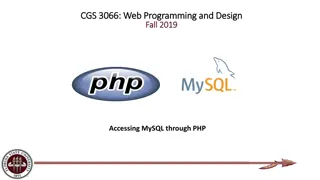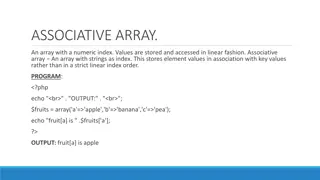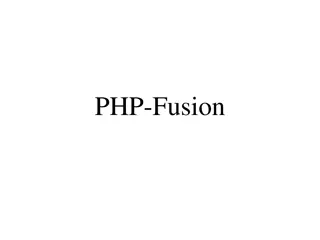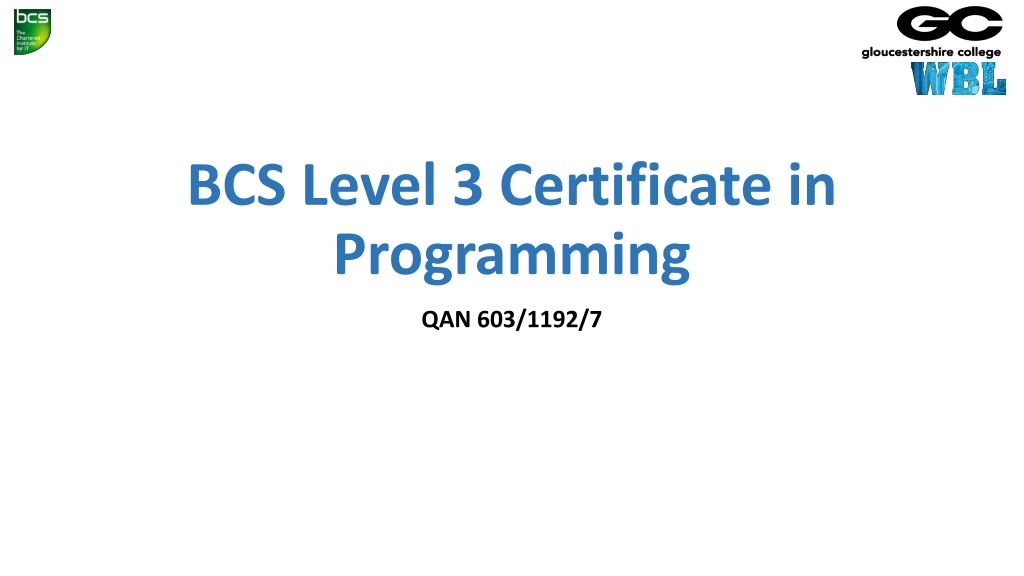
Understanding Security in Software Development
This content delves into the importance of integrating security measures into software development processes and explores various security issues, threats, and attack methods developers need to be aware of. It emphasizes the need for proactive security approaches, discusses the lack of security training for developers, and highlights common security attacks, social engineering tactics, and the concept of security versus resilience. The content also explains how social engineering attacks work and provides insights into preparatory steps and execution methods used by cyber attackers.
Download Presentation

Please find below an Image/Link to download the presentation.
The content on the website is provided AS IS for your information and personal use only. It may not be sold, licensed, or shared on other websites without obtaining consent from the author. If you encounter any issues during the download, it is possible that the publisher has removed the file from their server.
You are allowed to download the files provided on this website for personal or commercial use, subject to the condition that they are used lawfully. All files are the property of their respective owners.
The content on the website is provided AS IS for your information and personal use only. It may not be sold, licensed, or shared on other websites without obtaining consent from the author.
E N D
Presentation Transcript
BCS Level 3 Certificate in Programming QAN 603/1192/7
Learning Outcomes Understand the importance of building security in to software at the development stage. 9.1 software development Describe the following types of security issues and the scale and nature of threats that can impact 9.2 creating a secure end-product, and why it is important. Explain what is meant by 'building security in', in terms of secure software development and 9.3 Describe proactive security approaches during software design and development. 9.4 Explain approaches to make software more secure.
9.1 nature of threats that can impact software development In this section we will be looking at: common security attacks; security versus resilience; social engineering Describe the following types of security issues and the scale and
Developers are not trained to write secure code, nor are they incentivized to write secure code
Common Security Attacks Security attacks do not just occur on the web Prevalent in operating system software and desktop applications
Security Versus Resilience Security Resilience Concerned with the physical Can you continue? Not how to mitigate, but how to fix How to continue? How long before a fix is available
Social Engineering Social engineering is a non-technical strategy cyber attackers use that relies heavily on human interaction and often involves tricking people into breaking standard security practices. ... When successful, many social engineering attacks enable attackers to gain legitimate, authorized access to confidential information
How it is done How it is done Preparing the ground for attack: Identifying the victim(s) Gathering background information Selecting attack method(s) Preparing the ground for attack: Deceiving the victim(s) to gain a foothold: Spinning a story Taking control of the interaction Deceiving the victim(s) to gain a foothold: Closing the interaction, ideally without arousing suspicion: Bringing the charade to a natural end Removing all traces of malware Covering tracks Closing the interaction, ideally without arousing suspicion: Obtaining the information over a period of time: Expanding foothold Executing the attack Obtaining the information over a period of time:
Five most common forms of digital social engineering assaults Baiting attacks Scareware attacks Pretexting Phishing Spear phishing Use a false promise to pique a victim s greed or curiosity Scareware involves victims being bombarded with false alarms and fictitious threats Obtains information through a series of cleverly crafted lies One of the most popular social engineering attack types A more targeted version of the phishing scam whereby an attacker chooses specific individuals or enterprises The most reviled form of baiting uses physical media to disperse malware. Scareware is also referred to as deception software, rogue scanner software and fraudware. Baiting scams don t necessarily have to be carried out in the physical world Scareware is also distributed via spam email that doles out bogus warnings, or makes offers for users to buy worthless/harmful services.
9.2 development and creating a secure end-product, and why it is important. Explain what is meant by 'building security in', in terms of secure software We will cover: the role coders play in determining a secure software end-product the impact they can have on security by not building security in why building security in at the start is better than trying to retrofit later People often represent the weakest link in the security chain and are chronically responsible for the failure of security systems.
Building Security In How we approach risk? Application Security Issue-based, short-term approach Penetrate and Patch Threat Modelling Code Reviews
Building Security In How we approach risk? Software Security Holistic, long-term approach Root Cause Analysis Organizational Change
Software Risk Management and Secure Software Development Life Cycles (S-SDLC)
Role Coders Play Coders traditionally have not worried too much about security To be most effective, secure coding training for developers needs to be an integral part of the overall software development process Everyone who touches an application from development through testing and into production needs to be driving toward a set of shared security goals For the application developer, it starts with a good understanding of the major components of the software development lifecycle (SDLC) You then need to decide what secure coding principles should apply at each stage in the process
Impact of not building in Security - What are the costs? Application Security Costs: Software Security Costs: Defect Management: 5 defects/KLOC, $ 30,000/KLOC (Business week) Patch Management: 1000 servers, $ 300,000 to test and deploy a patch (Gartner) Loss of productivity due of loss of service: $ 500 ML lost from DoS attack (Microsoft) Unbudgeted time to fix security problems:1000 man- hours (Microsoft) Cost of training software developers in security: $100 Million (Microsoft) Inadequate software testing costs: $3.3 billion (NIST)
Building Security In At The Start Is Better Than Trying To Retrofit Later The science of software security concerns constructing secure software This entails providing the software with a structure and design that ensures it is secure Involves teaching software developers, constructors and end users the way to construct secure software
Building Security In At The Start Is Better Than Trying To Retrofit Later The cost of removing an application security vulnerability during the design phase ranges from 30-60 times less than if removed during production. - NIST, IBM, and Gartner Group
9.3 Describe proactive security approaches during software design and development Items to be discussed in this section: security development lifecycle (SDLC) defensive design / defensive programming test creation and execution permission setting and role based access physical infrastructure and security
Security Development Lifecycle (SDLC);
SDLC Introduction Requirements Analysis Release Design Testing Implementation
Requirements Analysis Work closely with customer(s) Identify the problem to be solved Focus on what not how End result: functional specification Reviewed by customer and designers Requirements exist to define the functional security requirements implemented in the product, and include all the activities of the SDL. They are used as an enforcement point to ensure that all pieces are properly considered.
Design Focus on the how Break up the problem into smaller pieces Decide on how each component works and how they will work together End result: design specification Reviewed by designers and implementers The design phase of the SDL consists of activities that occur (hopefully) prior to writing code Secure design is about quantifying an architecture (for a single feature or the entire product) and then searching for problems
Implementation or coding Write code according to the design Often the shortest phase End result: program code Reviewed by designers, coders, testers For security we use implementation tools for testing Static application security testing (SAST) Dynamic application security testing (DAST)
SAST and DAST SAST SAST is like a spell-checker for code, identifying potential vulnerabilities in the source code SAST runs against a nightly build or may be integrated into your IDE It may find and open new bugs in the bug management system nightly or prompt the developer to pause while coding to fix a problem in real time DAST DAST checks the application's runtime instantiation It spiders through an application to find all possible interfaces and then attempts to exploit common vulnerabilities in the application These tools are primarily used on web interfaces.
Testing Verify the code works according to the functional requirements Look for corner cases problem or situation that occurs only outside of normal operating parameters End result: test plan, program that works Reviewed by designers, coders, testers Formal test activities include security functional test plans, vulnerability scanning, and penetration testing
Release Phase Work closely with customer(s) Validate customer expectations Get feedback for next version Maintenance of this program End result: happy customer(s) , Release occurs when all the security activities are confirmed against the final build and the software is sent to customers (or made available for download)
Defensive Design / Defensive Programming Anticipating failures by adding supporting code to detect, isolate, and if possible recover from the failure. Application software often requires a user to input information into a system which might include: Username/password Contact details Current date Input into a search box Building up a shopping cart Entering data into a database
Common element??? People!!!
Defensive design Defensive design is the practice of anticipating every possible way that an end-user could misuse a system or device During the defensive design process, methods are put in place to eliminate misuse. If this is not completely possible then it will aim to minimise the negative consequences Defensive design has not been good enough when The program crashes The program behaves in an unintended fashion Data security has been compromised .
Test Creation and Execution The Most Important Phase of Testing Test Plan is a dynamic document The success of a testing project depends upon a well-written test plan document that is current at all times Test Plan is more or less like a blueprint of how the testing activity is going to take place in a project
Permission Setting and Role Based Access Permissions are granted to minimise risk Users are granted permissions at the authorisation layer of any software login system Roles conceptually represent a named collection of permissions Usually reserved for administrators (who have certain permissions)
Physical Infrastructure and Security Effective physical security of an asset is achieved by multi-layering the different measures, what is commonly referred to as defence-in-depth The concept is based on the principle that the security of an asset is not significantly reduced with the loss of any single layer Layers could include: Perimeter Entry controls Delivery and isolation areas
Physical Infrastructure and Security Security of equipment should also be a priority Items would include: Power to the equipment and facility Backup power supply UPS Multiple feeds Fuel for backup generator Cabling security Equipment maintenance Off-site equipment security Secure disposal or re-use of equipment
9.4 Explain approaches to make software more secure Here we will cover: security scanning penetration testing fuzzing load testing
Security Scanning Also termed vulnerability scanners Helps to determine an organisation s exposure to attack from the internet or desktop applications Is an inspection of the potential points of exploit on a computer or network to identify security holes A vulnerability scan detects and classifies system weaknesses in computers, networks and communications equipment and predicts the effectiveness of countermeasures
Penetration Testing Penetration testing (also referred to as 'pen testing') is an effective method of determining the security of networks and web applications, helping organisations identify the best way of protecting its assets Penetration testing is a core tool for analysing the security of IT systems, but it's not a magic bullet Definition: "A method for gaining assurance in the security of an IT system by attempting to breach some or all of that system's security, using the same tools and techniques as an adversary might."
Fuzzing Fuzzing or fuzz testing is an automated software testing technique that involves providing invalid, unexpected, or random data as inputs to a computer program The program is then monitored for exceptions such as crashes, or failing built-in code assertions or for finding potential memory leaks Is a black box testing technique Requires no access to source code
Load Testing It helps to identify the maximum operating capacity of an application as well as any bottlenecks and determine which element is causing degradation Load testing is performed to determine a system's behaviour under both normal and anticipated peak load conditions Ensures that a given function, program, or system can simply handle what it s designed to handle Related to its bigger, more brutal cousin, stress testing
Task 1 Click on the below links and explain in your own words what each attack is Types of Cyber Attacks Malware Phishing SQL Injection Attack Cross-Site Scripting (XSS) Denial of Service (DoS) Session Hijacking and Man-in-the-Middle Attacks Credential Reuse
Task 2 - SDLC Draw a SDLC and explain the stages Include any tools or methods used
Task 3 - Making software more secure What is load testing ? Explain what penetration testing is ? What is fuzzing ? What is the purpose of security scanners?
Task 4 - Defensive Programming In your own words explain the concept Defensive Design / Defensive Programming
Task 5 - Building Security In Explain what is meant by 'building security in', in terms of secure software development and creating a secure end-product, and why it is important. You may use the internet to help with your research




